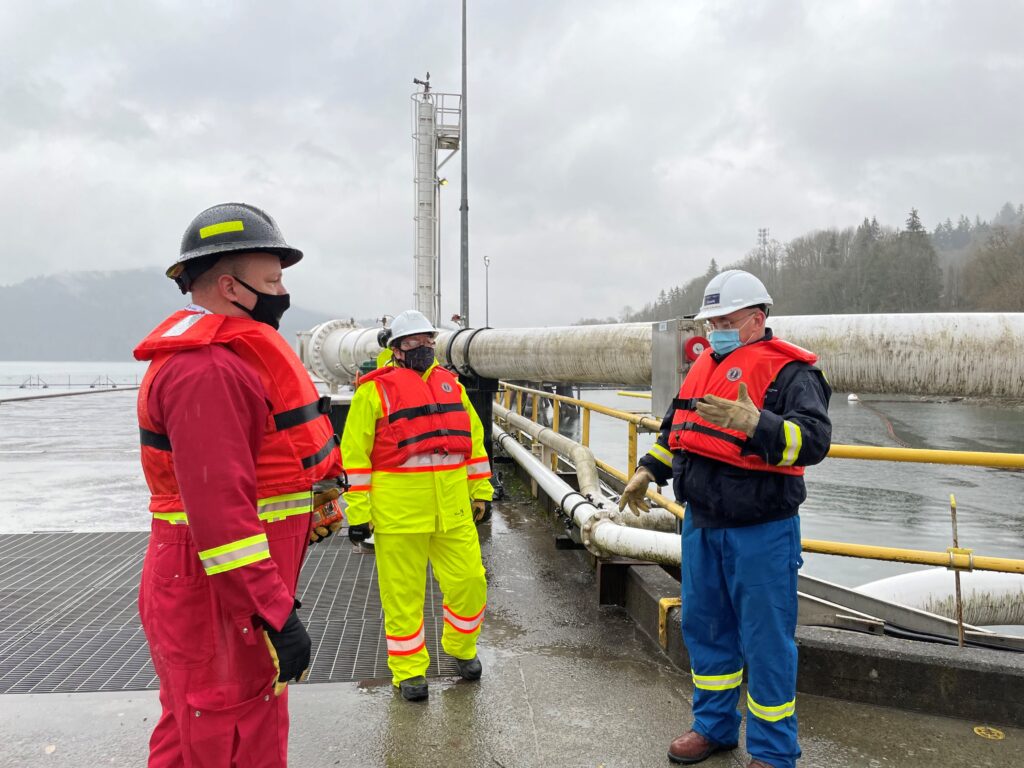April 7, 2021 – Vancouver, BC

Indigenous Monitors for the Indigenous Advisory and Monitoring Committee for the Trans Mountain Expansion and Existing Pipeline (IAMC-TMX) today celebrated the milestone of 100 joint compliance verification activities (CVA) by participating in an emergency management exercise in Burnaby, BC.
The exercise, consisting of training and a drill, took place on April 6th and 7th and was led by Trans Mountain Corporation out of their Westridge Marine Terminal. The drill included 150 virtual and in-person participants and involved an equipment deployment and a virtual and in- person Incident Command Post.
Working with the Canada Energy Regulator, Fisheries and Oceans Canada and Parks Canada, since 2017, Indigenous Monitors for the IAMC-TMX participate in oversight of the Trans Mountain Expansion (TMX) and Existing Pipeline through CVAs. This includes participating in emergency management exercises, safety and environmental protection inspections, and socio- economic reviews.
The IAMC-TMX brings together 13 Indigenous and six senior federal representatives to provide advice to regulators and to monitor the TMX and Existing Pipeline. Members have a shared goal of safety and protection of environmental and Indigenous interests in lands and waters. Participation by an Indigenous group does not mean that it supports or opposes the project.
Quotes
“The IAMC-TMX was established to form the basis of a new relationship between Indigenous Communities, the Government and regulators in respect of the Trans Mountain activities. I am thrilled to see that our monitors have reached the 100 CVA milestone but know that the job is far from finished.”
– Michelle Wilsdon, Co-Chair, IAMC-TMX Indigenous Advisory and Monitoring Committee
“The IAMC-TMX is a great example of a working partnership between Indigenous people and the Government of Canada. A core part of that partnership is the Indigenous Monitoring Program, which supports Indigenous participation in the federal regulation of the TMX and its monitors are full participants in Compliance Verification Activities.”
– Tracy Fleck, Co-Chair, IAMC-TMX Indigenous Advisory and Monitoring Committee
“One of the main priorities of the Indigenous Monitoring Subcommittee is to enable Indigenous participation and to integrate Indigenous Knowledge, values and perspectives into federal oversight of the TMX Project. Reaching the milestone of 100 CVAs is a moment to reflect on a job well-done.”
– Raymond Cardinal, Chair, Indigenous Monitoring Subcommittee
“I have derived a great amount of satisfaction from being one of the Indigenous Monitors for the TMX Project and being chosen to participate in an emergency management exercise as the 100th CVA is a great honour.”
– Tana Mussell, Indigenous Monitor
“With gratitude resonating from my heart, my hands go up to the finned, the winged, the two- legged, the four-legged, the rooted, the flowing, and my Chawathil Leadership and community, to be their eyes, ears, voice, and boots on the ground.”
– Bobbi Ellen Roberts, IAMC-TMX Indigenous Monitor
Quick Facts
- In 2016, the Government of Canada announced the creation of an Indigenous Advisory and Monitoring Committee for the TMX and Existing Pipeline (IAMC-TMX) when it approved the Project.
- The IAMC-TMX Indigenous Monitoring program began as a pilot program in 2017. The first joint Compliance Verification Activity in which Indigenous Monitors fully participated was a full-scale emergency response river deployment exercise in the Jasper area.
- IAMC Indigenous Monitors are full participants in Compliance Verification Activities and separate from the TMX Indigenous Monitoring Program.
For More Information:
www.iamc.ca
www.facebook.com/iamc.tmx
https://twitter.com/iamc_tmx
Contact:
Kathy Liu
IAMC-TMX Communications
604-355-2977
kathy.liu@canada.ca

















